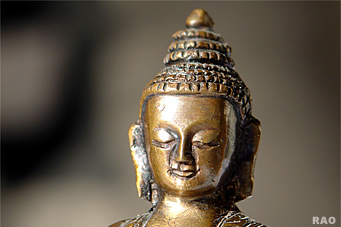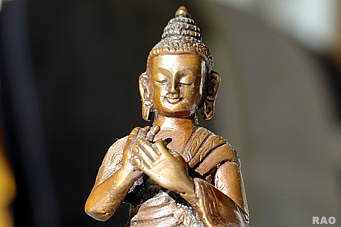|
Religions
in Nepal: An introduction |
 |
| Nepal
is one of the most peaceful multi-religious country in the world where
more than 60 different ethnic-groups with their own religions, cultures
and languages live respecting each other in perfect harmony. It must
be remembered here that Nepal in her long cultural history never saw any
ethnic violence or a war caused by religious motivations. |
|
The
king in Nepal is traditionally regarded as a living symbol of religious
harmony. Hindu tradition honours him as the incarnation of Vishnu, the
Hindu god of preservationand the Buddhist tradition honours him as the
Buddhist god of coMapssion and public welfare. Hinduism and Buddhism, the
two main religions of this country from time immemorial have been intermingled
with each other so much that it is almost impossible now toseparate one
from another.
Hinduism,
which is one of the oldest faiths in the world, is deeply rooted in the
Vedas (the holiest Hindu scriptures) whose antiquity goes way back to 2000
B.C. Accordingto Hindu philosophy the ultimate goal of one's life is liberation
or Mokshya. There are three different paths recommended to reach for this
goal such as- Artha- (economic efficiency) Dharma - (righteousness) and
Kama - (Devotion to family) which are basically designed to gradually lead
one from Bhakti or material world (attachment) to Muktior Mokshya, the
state of supreme bliss (detachment) at the end. This is the philosophical
aspect of religion.
Another
aspect of this religion that is very common, is the ritual aspect. The
ritual aspect takes care of the routine work of people's everyday life.
Majority in Nepal are still very religious minded. They get up early in
the mornings and go to temples for prayer. Some finish their prayer or
puja rituals very quickly. Some stay longer and perform it in much greater
details and make themselves feel very good.
Nepal
being a land of temples, the number of temples here counts in thousands.
Some are dedicated to the Hindu gods and some to the Buddhist gods. Quite
a number of them stand very close to each other - indicating Nepalese respect
for various faiths.
The
recorded history of Buddhism in Nepal beings with Lumbini, the birthplace
of Buddha where the Indian Emperor erected a stone pillar to commemorate
his pilgrimage to that place. Besides this many other archeological ruins
found in Kapilvastu and in the vicinity also indicate that many historical
buildings were built there some 600 yearsbefore Christ. Buddhism later
with the passage of time underwent many socio-religious upheavals making
Buddha, the founder of Buddhism himself a mysterious figure ofthe mixed
religion.
Some
of the images you see in the old Hindu temples here may look very complicated
to you. The icons of the multi-armed deities holding various attributives
indicate that they belong to the tantric sect of Hinduism. The worship
with the animal sacrifice in such temple is very common in Nepal.
Now
we discuss a bit about the significance of sacrifice in Hindu religion.
The
tantric elements
 |
| There
are many kinds of sacrifices. To give away food and clothes to the needy
and poor is also a kind of sacrifice. Offering rice, flowers and fruits
to the temple deities also signify the devotees' sacrifice. This certainly
makes some sense. However the animal sacrifice which is very common in
Nepal has a different story to tell. According to some tantric priests
- animal sacrifice in the temple - represents the worshipper's willingness
to sacrifice everything valuable he owns for the sake of religion. Many
still seem to respect this tantric tradition. |
|
Here
is a very interesting symbolism story associated with the animal sacrifice.
A custom has it that animals chosen for this purpose always be the male
never female.
There
are five kinds of animals - accepted for the sacrificial ritual. They are
water buffaloes, goats, sheep, chicken and duck. The tantric symbolism
story has it that the water buffaloes stand for stupidity and apathy respectively.
The animal sacrifice is quite frequently practiced in the tantric temples
of Nepal. Another interesting aspect of religion is the folk belief, which
still works here in many parts of Nepal.
When
you you have lost a key to your room and never found it. What to do? Don't
you worry any way? Nepal has a very special god for this problem to solve.
He is known as Cho-po Ganesh, the god of lost and found. Very easy to please.
All you have to do is to buy him sweet laddus (his favorite) as much as
you can. Your lost key is found in no time.
Besides
this Nepal has also many other gods for different problems such as a god
for toothache, a god for stomach pain and so on. All of them are believed
to provide the immediate relief to their suffering devotees.
| 




